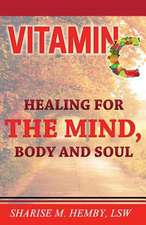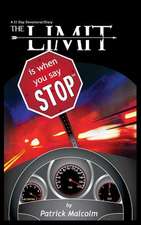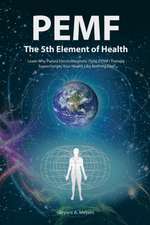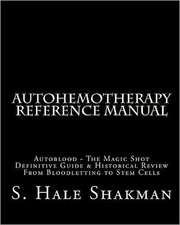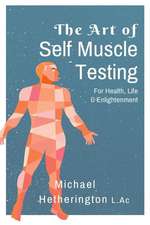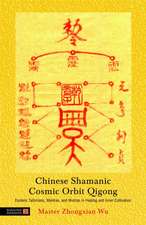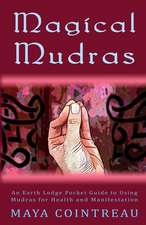Light Therapies: A Complete Guide to the Healing Power of Light
Autor Anadi Martel Cuvânt înainte de Jacob Liberman O.D., Ph.D.en Limba Engleză Paperback – 28 iun 2018
A comprehensive guide to the therapeutic benefits of light and color and how they affect our physical and psychological well-being
Beginning with sun worship in prehistory and sunshine therapies in ancient Egypt, Greece, and India, light has long been associated with the sublime, the divine, and healing. Yet only recently have we begun to understand how different parts of the light spectrum, from infrared to ultraviolet, can affect our physical and psychological well-being.
Covering the historic, scientific, and spiritual aspects of light and its role in energy medicine, Anadi Martel explores the vibrational nature of light and the interaction between light, biology, and consciousness. He demonstrates light’s incredible effects on the physical, energetic, and cognitive dimensions of life and examines several forms of light therapy, including chromotherapy (color therapy), heliotherapy (sun therapy), actinotherapy (ultraviolet therapy), and thermotherapy (infrared therapy). He details how to use light therapy daily, get optimal benefits from sunlight, and avoid the health risks of new artificial lighting such as compact fluorescents and LEDs. Combining his own 30 years of research with practical insight from the many phototherapy pioneers he’s encountered, the author examines scientific studies on how specific wavelengths of light influence our cells and DNA, brain function, sleep patterns, and emotional stability; speed the healing of wounds; and are effective in the treatment of disease, including arthritis, stroke, Alzheimer’s, Parkinson’s, and brain and nerve injuries. Exploring the spiritual aspects of light, the author explains why auras and halos have been used to represent sages and saints of all traditions, revealing the intimate link between light and consciousness.
Beginning with sun worship in prehistory and sunshine therapies in ancient Egypt, Greece, and India, light has long been associated with the sublime, the divine, and healing. Yet only recently have we begun to understand how different parts of the light spectrum, from infrared to ultraviolet, can affect our physical and psychological well-being.
Covering the historic, scientific, and spiritual aspects of light and its role in energy medicine, Anadi Martel explores the vibrational nature of light and the interaction between light, biology, and consciousness. He demonstrates light’s incredible effects on the physical, energetic, and cognitive dimensions of life and examines several forms of light therapy, including chromotherapy (color therapy), heliotherapy (sun therapy), actinotherapy (ultraviolet therapy), and thermotherapy (infrared therapy). He details how to use light therapy daily, get optimal benefits from sunlight, and avoid the health risks of new artificial lighting such as compact fluorescents and LEDs. Combining his own 30 years of research with practical insight from the many phototherapy pioneers he’s encountered, the author examines scientific studies on how specific wavelengths of light influence our cells and DNA, brain function, sleep patterns, and emotional stability; speed the healing of wounds; and are effective in the treatment of disease, including arthritis, stroke, Alzheimer’s, Parkinson’s, and brain and nerve injuries. Exploring the spiritual aspects of light, the author explains why auras and halos have been used to represent sages and saints of all traditions, revealing the intimate link between light and consciousness.
Preț: 128.27 lei
Preț vechi: 182.06 lei
-30% Nou
Puncte Express: 192
Preț estimativ în valută:
24.55€ • 25.53$ • 20.27£
24.55€ • 25.53$ • 20.27£
Carte disponibilă
Livrare economică 28 martie-09 aprilie
Livrare express 08-14 martie pentru 89.69 lei
Preluare comenzi: 021 569.72.76
Specificații
ISBN-13: 9781620557297
ISBN-10: 1620557290
Pagini: 384
Ilustrații: Full-color throughout
Dimensiuni: 152 x 229 x 23 mm
Greutate: 0.59 kg
Editura: Inner Traditions/Bear & Company
Colecția Healing Arts Press
ISBN-10: 1620557290
Pagini: 384
Ilustrații: Full-color throughout
Dimensiuni: 152 x 229 x 23 mm
Greutate: 0.59 kg
Editura: Inner Traditions/Bear & Company
Colecția Healing Arts Press
Notă biografică
Anadi Martel is a physicist and electronics designer, who has acted as a consultant for IMAX, Cirque du Soleil, and the Metropolitan Opera of New York. For more than 30 years he has researched the therapeutic properties of light and the interaction between technology and consciousness, leading to the creation of the Sensora multisensorial system. His sound spatialization devices have been used around the world, including by NASA. He serves as President of the International Light Association (ILA) and lives in Quebec.
Extras
Chapter 5
Light Medicine
The History and Uses of Phototherapy
We are still on the threshold of fully understanding the complex relationship between light and life, but we can now say emphatically, that the function of our entire metabolism is dependent on light.
--Fritz Albert Popp
Inspired by the discoveries of the biological pathways of light described in the previous chapter, light medicine (often called phototherapy) has been in full expansion since the beginning of the 21st century.
There are two main categories of phototherapy:
• First there is the type that makes use of the natural interactions that light already has with our bodies: endogenous phototherapy. It includes therapies based on photobiomodulation (the interaction of light and cell mitochondria) and chronobiology (the interaction of light and circadian rhythms). Endogenous phototherapy usually has regenerative properties and tends to reestablish natural order in a non-invasive way.
• Then there are therapies that use light as a catalyst in custom-made biological processes: synthetic phototherapy. They arise from our increasing understanding of the biochemistry of chromophores, those molecules capable of absorbing or emitting light, enabling us to make use of them in completely new ways. These therapies are generally more invasive and radical and are used for more aggressive interventions: for example dynamic phototherapy excels in the destruction of cancer cells, and ultraviolet phototherapy can heal certain infections and serious diseases through the sterilization of pathogens.
The Tools of Light Medicine
Lasers
Lasers generate light with very precise wavelengths and almost no divergence, allowing for a very fine and intense focal point. Several types of medical lasers are now in use including:
• Ablative lasers: often in the infrared range and very powerful, they can vaporize layers of the epidermis and are used in dermatology. Other types emit green light to vaporise vascularized tissue (since red blood best absorbs green light), used for tumour excision.
• Fractional lasers: their rays are fractured into tiny micro-beams making it possible to treat skin without harm. Used in aesthetic dermatology.
• Pulsed lasers: emit light in very intense but very short bursts in the range of a nanosecond (10-9 s) to a femtosecond (10-15 s). They are used as scalpels in surgery.
• Excimer (or exiplex) lasers: produce ultraviolet light and are used in the treatment of psoriasis and vitiligo.
• Laser diodes: low intensity semiconductor lasers that are more compact and economical than other types of lasers. Used for photobiomodulation to reach specific spots in deep tissue.
Intense Pulsed Light (IPL)
Flashing lamps, fitted with coloured filters and emitting several powerful pulses per second, are increasingly used in dermatology and aesthetic medicine. The best ones have an integrated cooling system to improve comfort.
LEDs
These can replace lasers in certain applications, particularly in photobiomodulation. Medical LEDs come in a wide variety of strengths and optical beam widths. Different colours are used for different purposes: infrared and red for photobiomodulation, amber for aesthetics, green and blue for acne and chronobiology, ultraviolet in dentistry and for sterilization.
Fluorescent lamps
These are mostly used in the treatment of depression and in other chronobiological applications.
Photobiomodulation Therapy
Photobiomodulation intervenes at the very source of the cell's regenerative abilities. All ancient peoples, as well as the light therapy pioneers of the last century, used it intuitively. But it was not until the invention of the laser in the 1960s that its use in medicine first began, followed by a surge in its popularity as a result of the discoveries of Professor Tiina Karu in the 1990s.
Given the fundamental nature of the cellular processes involved in photobiomodulation, it is not surprising that the scope of possible applications keeps expanding. These applications include:
• Repair and regeneration of tissues by the bio-stimulation of cellular metabolism (for wounds, muscle trauma, hair loss, macular degeneration, regeneration of internal organs such as the heart, liver and kidneys)
• Stimulation of the immune system resulting in a lowering of inflammation (for dermatitis, eczema, asthma, arthritis) Pain relief (for post-operative pain, dental treatments, mucositis)
• Neurological effects, both physiological and cognitive (for brain trauma, strokes, depression, memory problems, dementia)
A Well-Kept Secret?
Photobiomodulation is already being applied by many specialists. High performance athletes (for example in the Tour de France) and the military have utilized it for several years now to treat muscle trauma or tendinitis, and astronauts have been using it longer still. Why then, apart from a few exceptions in sports medicine, would photobiomodulation not be more prevalent?
This can be partly explained by the fact that many of the applications of photobiomodulation are still experimental. Even if numerous clinical studies have shown convincing results, protocols still need to be established and the necessary clinical experience acquired before it can be put to general use.
It will therefore probably take a few more years before the remarkable treatments of photobiomodulation become readily available for all. Even after purely technical issues have been resolved, inertia in the medical system delays the practice of treatments that are radically different from those in common use.
The implementation of photobiomodulation varies greatly from one country to another. Russia is often at the forefront in this field. There phototherapy treatments are relatively common, including innovative applications such as those used for the prevention of heart problems (angina, cardiac arrest, and others).
In the U.S. some devices have already met the strict rules of the Food and Drug Administration (FDA). The first one, in 2002, was designed to treat carpal tunnel syndrome. In 2008 the World Health Organization endorsed photobiomodulation for the treatment of cervical pain. And in 2010 the American Physical Therapy Association recommended it for the treatment of injuries to the Achilles tendon.
Slowly but surely, photobiomodulation is being integrated into our health habits.
Light Medicine
The History and Uses of Phototherapy
We are still on the threshold of fully understanding the complex relationship between light and life, but we can now say emphatically, that the function of our entire metabolism is dependent on light.
--Fritz Albert Popp
Inspired by the discoveries of the biological pathways of light described in the previous chapter, light medicine (often called phototherapy) has been in full expansion since the beginning of the 21st century.
There are two main categories of phototherapy:
• First there is the type that makes use of the natural interactions that light already has with our bodies: endogenous phototherapy. It includes therapies based on photobiomodulation (the interaction of light and cell mitochondria) and chronobiology (the interaction of light and circadian rhythms). Endogenous phototherapy usually has regenerative properties and tends to reestablish natural order in a non-invasive way.
• Then there are therapies that use light as a catalyst in custom-made biological processes: synthetic phototherapy. They arise from our increasing understanding of the biochemistry of chromophores, those molecules capable of absorbing or emitting light, enabling us to make use of them in completely new ways. These therapies are generally more invasive and radical and are used for more aggressive interventions: for example dynamic phototherapy excels in the destruction of cancer cells, and ultraviolet phototherapy can heal certain infections and serious diseases through the sterilization of pathogens.
The Tools of Light Medicine
Lasers
Lasers generate light with very precise wavelengths and almost no divergence, allowing for a very fine and intense focal point. Several types of medical lasers are now in use including:
• Ablative lasers: often in the infrared range and very powerful, they can vaporize layers of the epidermis and are used in dermatology. Other types emit green light to vaporise vascularized tissue (since red blood best absorbs green light), used for tumour excision.
• Fractional lasers: their rays are fractured into tiny micro-beams making it possible to treat skin without harm. Used in aesthetic dermatology.
• Pulsed lasers: emit light in very intense but very short bursts in the range of a nanosecond (10-9 s) to a femtosecond (10-15 s). They are used as scalpels in surgery.
• Excimer (or exiplex) lasers: produce ultraviolet light and are used in the treatment of psoriasis and vitiligo.
• Laser diodes: low intensity semiconductor lasers that are more compact and economical than other types of lasers. Used for photobiomodulation to reach specific spots in deep tissue.
Intense Pulsed Light (IPL)
Flashing lamps, fitted with coloured filters and emitting several powerful pulses per second, are increasingly used in dermatology and aesthetic medicine. The best ones have an integrated cooling system to improve comfort.
LEDs
These can replace lasers in certain applications, particularly in photobiomodulation. Medical LEDs come in a wide variety of strengths and optical beam widths. Different colours are used for different purposes: infrared and red for photobiomodulation, amber for aesthetics, green and blue for acne and chronobiology, ultraviolet in dentistry and for sterilization.
Fluorescent lamps
These are mostly used in the treatment of depression and in other chronobiological applications.
Photobiomodulation Therapy
Photobiomodulation intervenes at the very source of the cell's regenerative abilities. All ancient peoples, as well as the light therapy pioneers of the last century, used it intuitively. But it was not until the invention of the laser in the 1960s that its use in medicine first began, followed by a surge in its popularity as a result of the discoveries of Professor Tiina Karu in the 1990s.
Given the fundamental nature of the cellular processes involved in photobiomodulation, it is not surprising that the scope of possible applications keeps expanding. These applications include:
• Repair and regeneration of tissues by the bio-stimulation of cellular metabolism (for wounds, muscle trauma, hair loss, macular degeneration, regeneration of internal organs such as the heart, liver and kidneys)
• Stimulation of the immune system resulting in a lowering of inflammation (for dermatitis, eczema, asthma, arthritis) Pain relief (for post-operative pain, dental treatments, mucositis)
• Neurological effects, both physiological and cognitive (for brain trauma, strokes, depression, memory problems, dementia)
A Well-Kept Secret?
Photobiomodulation is already being applied by many specialists. High performance athletes (for example in the Tour de France) and the military have utilized it for several years now to treat muscle trauma or tendinitis, and astronauts have been using it longer still. Why then, apart from a few exceptions in sports medicine, would photobiomodulation not be more prevalent?
This can be partly explained by the fact that many of the applications of photobiomodulation are still experimental. Even if numerous clinical studies have shown convincing results, protocols still need to be established and the necessary clinical experience acquired before it can be put to general use.
It will therefore probably take a few more years before the remarkable treatments of photobiomodulation become readily available for all. Even after purely technical issues have been resolved, inertia in the medical system delays the practice of treatments that are radically different from those in common use.
The implementation of photobiomodulation varies greatly from one country to another. Russia is often at the forefront in this field. There phototherapy treatments are relatively common, including innovative applications such as those used for the prevention of heart problems (angina, cardiac arrest, and others).
In the U.S. some devices have already met the strict rules of the Food and Drug Administration (FDA). The first one, in 2002, was designed to treat carpal tunnel syndrome. In 2008 the World Health Organization endorsed photobiomodulation for the treatment of cervical pain. And in 2010 the American Physical Therapy Association recommended it for the treatment of injuries to the Achilles tendon.
Slowly but surely, photobiomodulation is being integrated into our health habits.
Cuprins
Foreword by Jacob Liberman
Preface
PART I
Understanding Light
1 The Origin of Light Therapy
Ancient and Modern Uses, Advancements, Controversies
2 A Short History of the Science of Light
Revelations from Crucial Experiments
3 What Is Light?
Physical Properties
PART II
Light’s Influence on Health
4 The Three Biological Pathways of Light
Entry and Influence
5 Light Medicine
The Modern Use of Phototherapy
6 Health Risks of Light
The Harmful Potential of Artificial Light
PART III
New Applications of Light
7 The Dawn of Energy Medicine
Integrating Vitalism and Science
8 Color Medicine
The History and Uses of Chromotherapy
9 Alternative Light Medicine
Modern Chromotherapy Technologies
PART IV
Cognitive Aspects of Light
10 Sync and Resonance
How Light and Sound Cause Biological Balance
11 Objective Light, Subjective Light
Using Light to Promote a Harmonious State of Being
12 Light and Consciousness
An Intimate Association
Postface
Glossary
References
Index
Preface
PART I
Understanding Light
1 The Origin of Light Therapy
Ancient and Modern Uses, Advancements, Controversies
2 A Short History of the Science of Light
Revelations from Crucial Experiments
3 What Is Light?
Physical Properties
PART II
Light’s Influence on Health
4 The Three Biological Pathways of Light
Entry and Influence
5 Light Medicine
The Modern Use of Phototherapy
6 Health Risks of Light
The Harmful Potential of Artificial Light
PART III
New Applications of Light
7 The Dawn of Energy Medicine
Integrating Vitalism and Science
8 Color Medicine
The History and Uses of Chromotherapy
9 Alternative Light Medicine
Modern Chromotherapy Technologies
PART IV
Cognitive Aspects of Light
10 Sync and Resonance
How Light and Sound Cause Biological Balance
11 Objective Light, Subjective Light
Using Light to Promote a Harmonious State of Being
12 Light and Consciousness
An Intimate Association
Postface
Glossary
References
Index
Recenzii
“A must-read for everyone interested in the field of light--beginners, experts, lay-people, health and wellness practitioners, teachers, and scientists.”
“Plants use light effectively. Why not humans? Would Mother Nature take a strategy developed so effectively for the plant kingdom and wantonly squander it as she created the animal kingdom? In an articulate and beautifully illustrated book, physicist and long-term president of the International Light Association Anadi Martel authoritatively describes the therapeutic effects of light in a comprehensive, reader-friendly fashion, beginning with the nature of light and the ancient history of light therapeutics all the way to the modern, exponentially growing field of science and medicine that uses light as a foundation. The book is liberally sprinkled with highlighted boxes containing little-known facts and fascinating insights. It’s a joy to read. Highly recommended.”
“In this wonderfully detailed and beautifully illustrated book, Anadi has thoroughly documented the present status of this rapidly advancing and very exciting field as has never been done before. Follow Anadi’s remarkable scientific and spiritual journey as he uncovers the essence of light and its diverse therapeutic applications. Here you will find the fascinating physics of light described with accuracy that can only be provided by a physicist but also with the clarity that can only come from a person with a real love and passion for communicating science in ways anyone can easily understand. As we move toward the medicine of the future, all of us need to know how light and color can benefit us. Whether light therapy is a new or an old subject for you, this is the most valuable, enjoyable, and up-to-date book you can read.”
“. . . a masterful work on the myriad applications of color and light. It is a pleasure to read for all who are interested in the fields of light and color. This book is a major contribution to the field and a valuable addition to any library.”
“Light Therapies is brilliant, a star among books about light. It is a must-read for everyone interested in the field of light--beginners, experts, lay-people,health and wellness practitioners, teachers, and scientists. It covers the broadest spectrum of information about the historic, scientific, healing, and spiritual aspects of light’s past, present, and future. . . . A spectacular achievement.”
“An important book that spearheads the new scientific paradigm in health and well-being. With profound insight, Martel explores how light lies at the very heart of our lives and outlines the effects of light on health, brain functions, cellular life, and our overall physical well-being. Here is a book that updates our understanding of physical reality--and how to benefit from it. Light Therapies will change the way we look at medical practice. Light medicine is the future, now. It will tell you everything you need to know--be informed!”
“Light Therapies is the best book on the subject I have ever come across. Anadi Martel gives descriptions of ALL of the therapeutic techniques using light and color that he has personally investigated and experimented with. Anadi is also an expert in Buddhist culture which completes his concept of light having three aspects: the physical, the energetic, and that of consciousness.”
“Anadi Martel has written a highly informative book on light therapies. It summarizes and explains the whole spectrum of light-based treatment methods and their broad applications in a beautifully illustrated manner. Surely, this volume will be very useful for beginners as well as for experts.”
“The kind of light that Anadi brings to us is beyond alternative therapy; it is the healing power of light to restore alignment between the physical and emotional bodies with the reality of the spiritual Source of all light.”
“For those who seek a deeper understanding of how light can heal our lives, this timely book is a must-read.”
"Light Therapies is a very in depth book covering al aspects of light...the main emphasis of this book is knowledge."
“Plants use light effectively. Why not humans? Would Mother Nature take a strategy developed so effectively for the plant kingdom and wantonly squander it as she created the animal kingdom? In an articulate and beautifully illustrated book, physicist and long-term president of the International Light Association Anadi Martel authoritatively describes the therapeutic effects of light in a comprehensive, reader-friendly fashion, beginning with the nature of light and the ancient history of light therapeutics all the way to the modern, exponentially growing field of science and medicine that uses light as a foundation. The book is liberally sprinkled with highlighted boxes containing little-known facts and fascinating insights. It’s a joy to read. Highly recommended.”
“In this wonderfully detailed and beautifully illustrated book, Anadi has thoroughly documented the present status of this rapidly advancing and very exciting field as has never been done before. Follow Anadi’s remarkable scientific and spiritual journey as he uncovers the essence of light and its diverse therapeutic applications. Here you will find the fascinating physics of light described with accuracy that can only be provided by a physicist but also with the clarity that can only come from a person with a real love and passion for communicating science in ways anyone can easily understand. As we move toward the medicine of the future, all of us need to know how light and color can benefit us. Whether light therapy is a new or an old subject for you, this is the most valuable, enjoyable, and up-to-date book you can read.”
“. . . a masterful work on the myriad applications of color and light. It is a pleasure to read for all who are interested in the fields of light and color. This book is a major contribution to the field and a valuable addition to any library.”
“Light Therapies is brilliant, a star among books about light. It is a must-read for everyone interested in the field of light--beginners, experts, lay-people,health and wellness practitioners, teachers, and scientists. It covers the broadest spectrum of information about the historic, scientific, healing, and spiritual aspects of light’s past, present, and future. . . . A spectacular achievement.”
“An important book that spearheads the new scientific paradigm in health and well-being. With profound insight, Martel explores how light lies at the very heart of our lives and outlines the effects of light on health, brain functions, cellular life, and our overall physical well-being. Here is a book that updates our understanding of physical reality--and how to benefit from it. Light Therapies will change the way we look at medical practice. Light medicine is the future, now. It will tell you everything you need to know--be informed!”
“Light Therapies is the best book on the subject I have ever come across. Anadi Martel gives descriptions of ALL of the therapeutic techniques using light and color that he has personally investigated and experimented with. Anadi is also an expert in Buddhist culture which completes his concept of light having three aspects: the physical, the energetic, and that of consciousness.”
“Anadi Martel has written a highly informative book on light therapies. It summarizes and explains the whole spectrum of light-based treatment methods and their broad applications in a beautifully illustrated manner. Surely, this volume will be very useful for beginners as well as for experts.”
“The kind of light that Anadi brings to us is beyond alternative therapy; it is the healing power of light to restore alignment between the physical and emotional bodies with the reality of the spiritual Source of all light.”
“For those who seek a deeper understanding of how light can heal our lives, this timely book is a must-read.”
"Light Therapies is a very in depth book covering al aspects of light...the main emphasis of this book is knowledge."
Descriere
A comprehensive guide to the therapeutic benefits of light and color and how they affect our physical and psychological well-being







